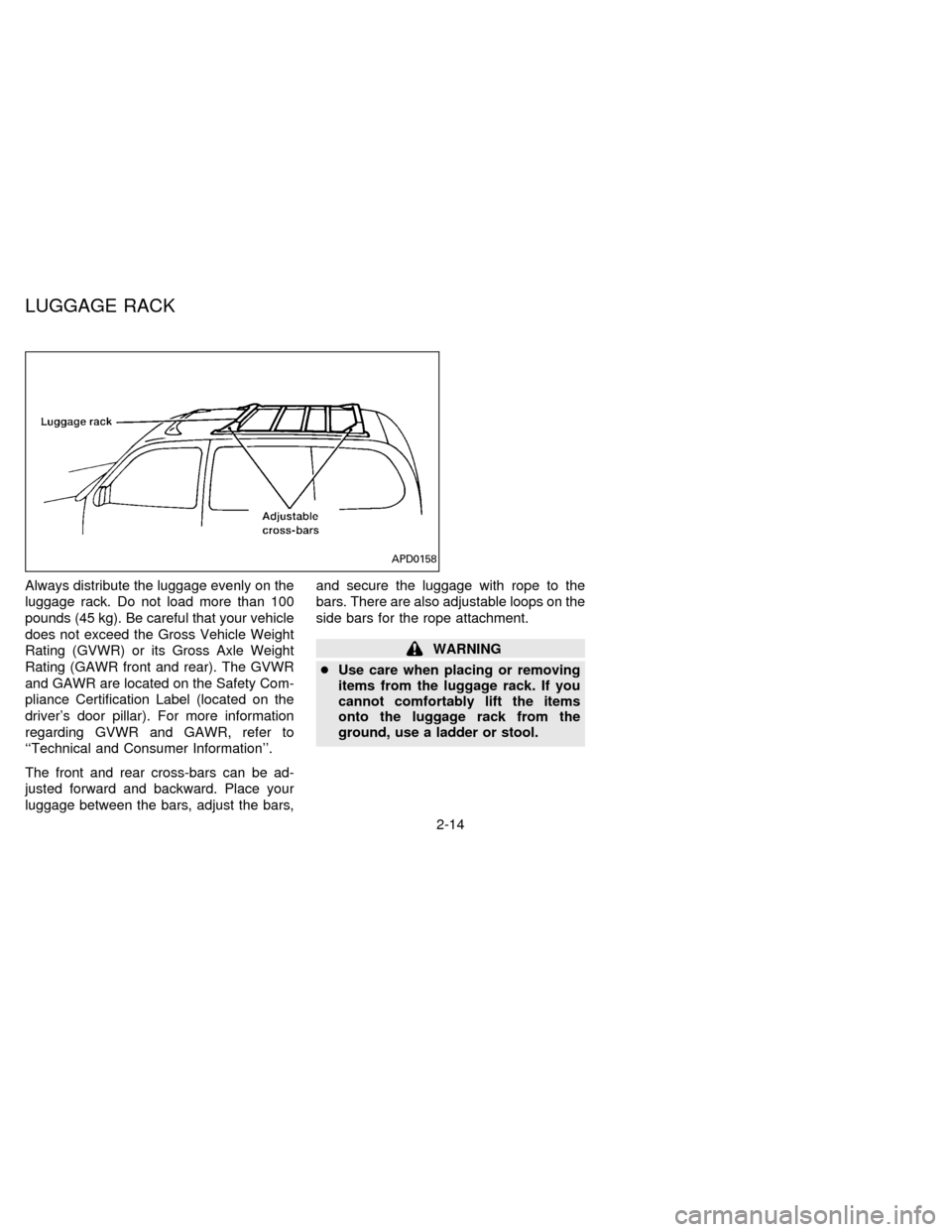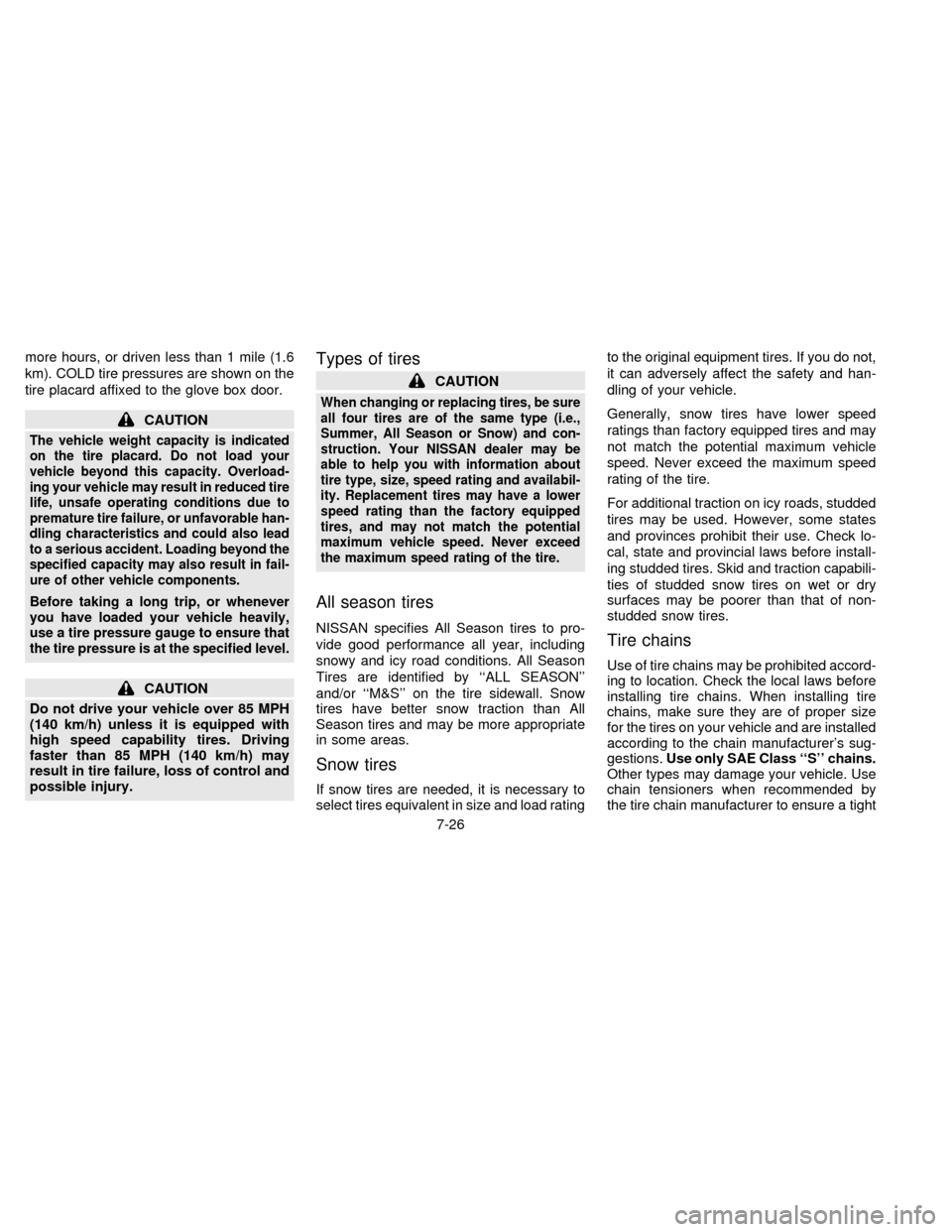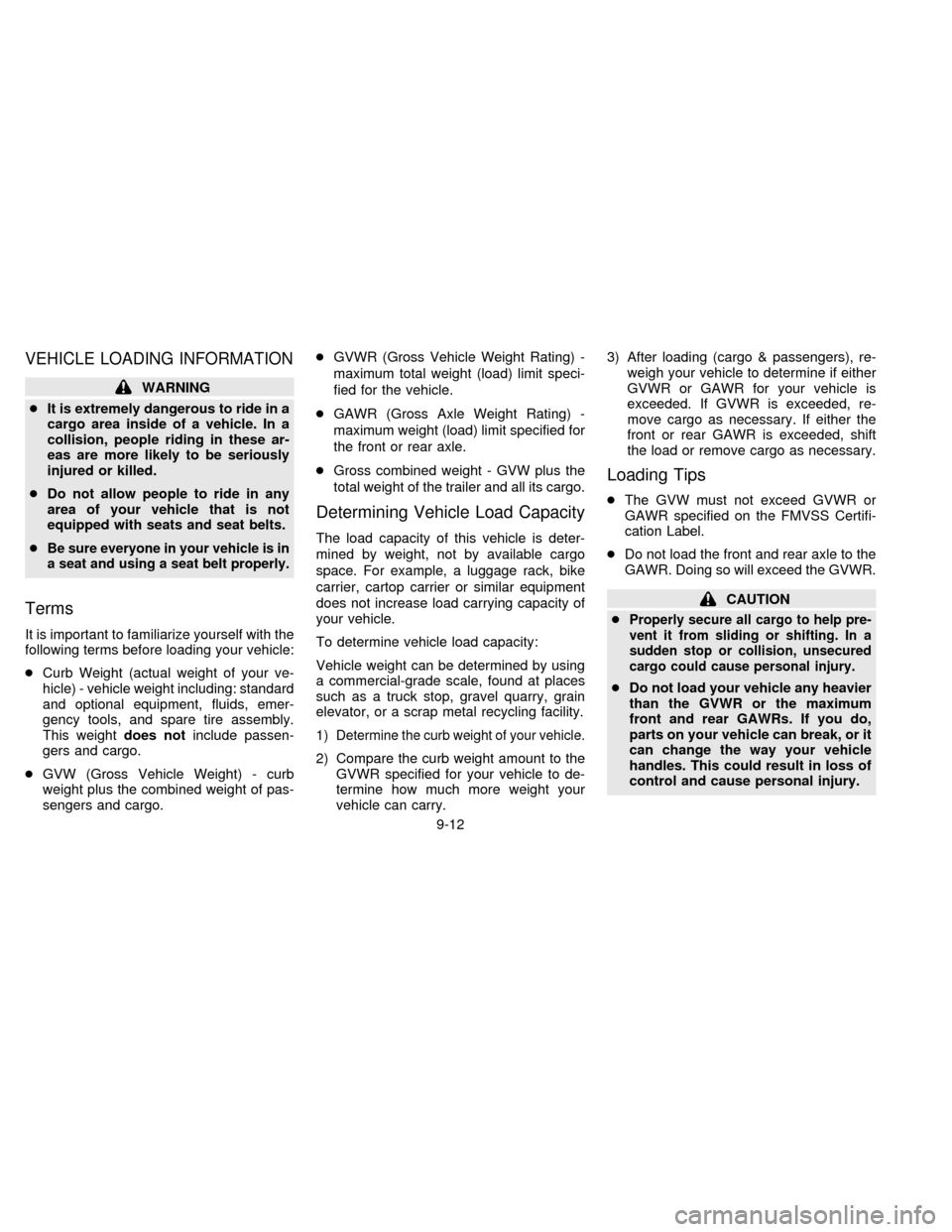1996 NISSAN QUEST weight
[x] Cancel search: weightPage 2 of 235

Welcome To The World Of NISSAN
Your new Nissan is the result of our dedication to
produce the finest in safe, reliable and economi-
cal transportation. Your vehicle is the product of
a successful worldwide company that manufac-
tures cars and trucks in over 20 countries and
distributes them in 150 nations.
Nissan vehicles are designed and manufactured
by Nissan Motor Co., Ltd. which was founded in
Tokyo, Japan in 1933, and Nissan affiliates
worldwide, collectively growing to become the
fourth largest automaker in the world. In addition
to cars and trucks, Nissan also makes textile
machinery, forklift trucks, marine engines, boats
and other products.
Nissan has made a substantial and growing
investment in North America, starting with the
opening of Nissan Motor Corporation U.S.A. in
1960, continuing with the production of some
cars and trucks at one of the world's mostmodern manufacturing facilities in Smyrna, Ten-
nessee, vehicle styling at Nissan Design Interna-
tional in San Diego, California, and engineering
at Nissan Research and Development in Farm-
ington Hills, Michigan.
Nissan Motor Corporation U.S.A. and its dealers
employ about 50,000 Americans.
Nissan is also a substantial contributor to the
Canadian economy. Nissan Canada Inc. and its
200 dealers and suppliers employ approximately
4,000 people. These include company employ-
ees and the staffs of Nissan dealers all across
Canada. In addition, many Canadians work for
companies that supply Nissan and Nissan deal-
ers with materials and services ranging from the
operation of port facilities and transportation ser-
vices, to the supply of lubricants, parts and
accessories.Nissan pioneered the use of electronics and
computers in automobiles, and has led the indus-
try in improving both performance and fuel effi-
ciency through new engine designs and the use
of synthetic materials to reduce vehicle weight.
The company has also developed ways to build
quality into its vehicles at each stage of the
production process, both through extensive use
of automation and Ð most importantly Ð
through an awareness thatpeopleare the cen-
tral element in quality control.
From the time the parts arrived from our suppli-
ers until you took delivery of your new Nissan,
dozens of checks were made to ensure that only
the best job was being done in producing and
delivering your vehicle. Nissan also takes great
care to ensure that when you take your Nissan to
your dealer for maintenance, the service techni-
cian will perform his work according to the quality
standards that have been established by the
factory.
Safety has also been built into your Nissan. As
you know, seat belts are an integral part of the
safety systems that will help protect you and your
passengers in the event of a sudden stop or an
accident. We urge you to use the belts every time
you drive the vehicle.
The Nissan story of growth and achievement
reflects our major goal: to provide you, our
customer, with a vehicle that is built with quality
and craftsmanship Ð a product that we can be
proud to build and you can be proud to own.
AFW0001
The inside pages of this manual contain
a minimum of 50% recycled fibers,
including 10% post-consumer fibers.
ZX
Page 43 of 235

Always distribute the luggage evenly on the
luggage rack. Do not load more than 100
pounds (45 kg). Be careful that your vehicle
does not exceed the Gross Vehicle Weight
Rating (GVWR) or its Gross Axle Weight
Rating (GAWR front and rear). The GVWR
and GAWR are located on the Safety Com-
pliance Certification Label (located on the
driver's door pillar). For more information
regarding GVWR and GAWR, refer to
``Technical and Consumer Information''.
The front and rear cross-bars can be ad-
justed forward and backward. Place your
luggage between the bars, adjust the bars,and secure the luggage with rope to the
bars. There are also adjustable loops on the
side bars for the rope attachment.
WARNING
cUse care when placing or removing
items from the luggage rack. If you
cannot comfortably lift the items
onto the luggage rack from the
ground, use a ladder or stool.
APD0158
LUGGAGE RACK
2-14
ZX
Page 99 of 235

Securing the Child
The following steps apply to both the left
and right integrated child safety seats.
1. Be sure your child meets all of the re-
quired age, weight and height require-
ments for the safe use of the integrated
child safety seat.
2. Be sure the second row bench seat is
securely latched to the floor of the ve-
hicle. Refer to the ``FLEXIBLE SEAT-
ING'' section in this chapter for proper
seat installation procedures.
3. Be sure the second row bench seatback
is locked by grasping it and trying to rock
it back and forth. Also, check that the
seatback release lever is in the full down
position.4. Pull the cushion release strap and lower
the intregrated child safety seat cushion
completely.
APD0813
2-70
ZX
Page 193 of 235

more hours, or driven less than 1 mile (1.6
km). COLD tire pressures are shown on the
tire placard affixed to the glove box door.
CAUTION
The vehicle weight capacity is indicated
on the tire placard. Do not load your
vehicle beyond this capacity. Overload-
ing your vehicle may result in reduced tire
life, unsafe operating conditions due to
premature tire failure, or unfavorable han-
dling characteristics and could also lead
to a serious accident. Loading beyond the
specified capacity may also result in fail-
ure of other vehicle components.
Before taking a long trip, or whenever
you have loaded your vehicle heavily,
use a tire pressure gauge to ensure that
the tire pressure is at the specified level.
CAUTION
Do not drive your vehicle over 85 MPH
(140 km/h) unless it is equipped with
high speed capability tires. Driving
faster than 85 MPH (140 km/h) may
result in tire failure, loss of control and
possible injury.
Types of tires
CAUTION
When changing or replacing tires, be sure
all four tires are of the same type (i.e.,
Summer, All Season or Snow) and con-
struction. Your NISSAN dealer may be
able to help you with information about
tire type, size, speed rating and availabil-
ity. Replacement tires may have a lower
speed rating than the factory equipped
tires, and may not match the potential
maximum vehicle speed. Never exceed
the maximum speed rating of the tire.
All season tires
NISSAN specifies All Season tires to pro-
vide good performance all year, including
snowy and icy road conditions. All Season
Tires are identified by ``ALL SEASON''
and/or ``M&S'' on the tire sidewall. Snow
tires have better snow traction than All
Season tires and may be more appropriate
in some areas.
Snow tires
If snow tires are needed, it is necessary to
select tires equivalent in size and load ratingto the original equipment tires. If you do not,
it can adversely affect the safety and han-
dling of your vehicle.
Generally, snow tires have lower speed
ratings than factory equipped tires and may
not match the potential maximum vehicle
speed. Never exceed the maximum speed
rating of the tire.
For additional traction on icy roads, studded
tires may be used. However, some states
and provinces prohibit their use. Check lo-
cal, state and provincial laws before install-
ing studded tires. Skid and traction capabili-
ties of studded snow tires on wet or dry
surfaces may be poorer than that of non-
studded snow tires.
Tire chains
Use of tire chains may be prohibited accord-
ing to location. Check the local laws before
installing tire chains. When installing tire
chains, make sure they are of proper size
for the tires on your vehicle and are installed
according to the chain manufacturer's sug-
gestions.Use only SAE Class ``S'' chains.
Other types may damage your vehicle. Use
chain tensioners when recommended by
the tire chain manufacturer to ensure a tight
7-26
ZB13-DX
Page 210 of 235

9 Technical and consumer information
Capacities and recommended
fuel/lubricants ....................................................... 9-2
Engine .................................................................. 9-7
Wheel/tire size ...................................................... 9-8
Dimensions and weights ...................................... 9-8
Registering your vehicle
in another country ................................................ 9-9
Vehicle identification............................................. 9-9Installing the license plate .................................. 9-11
Vehicle loading information ................................ 9-12
Trailer towing ...................................................... 9-13
Uniform tire quality grading ................................ 9-18
Emission control system warranty ..................... 9-19
Reporting safety defects (USA) ......................... 9-19
NISSAN service/owner's manual order form ..... 9-20
ZX
Page 217 of 235

Road wheel Steel 5-1/2 - JJ ý 15
Aluminum 6-1/2 - JJ ý 15
Offset in (mm) 1.77 (45)
Tire size Conventional P205/75R15 97 S
Cast aluminum* P205/75R15 97 S
P215/70R15 97 T
Spare T125/90D16
P205/75R15 97 S*
P215/70R15 97 T*
*: OptionOverall length in (mm) 189.9 (4,824)
Overall width in (mm) 73.7 (1,871)
Overall height in (mm) 67.6 (1,716)
Front tread in (mm) 63.4 (1,610)
Rear tread in (mm) 63.4 (1,610)
Wheelbase in (mm) 112.2 (2,850)
Gross vehicle weight
rating lb (kg)
See the ``F.M.V.S.S. certification label''
on the left center pillar. Gross axle weight rating
Front lb (kg)
Rear lb (kg)
WHEEL/TIRE SIZE DIMENSIONS AND WEIGHTS
9-8
ZX
Page 219 of 235

F.M.V.S.S. CERTIFICATION
LABEL
The F.M.V.S.S. certification label is affixed
as shown. This label contains valuable ve-
hicle information, such as: Gross VehicleWeight Rating (GVWR), Gross Axle Weight
Rating (GAWR), month and year of manu-
facture, Vehicle Identification Number
(VIN), etc. Review it carefully.
EMISSION CONTROL
INFORMATION LABEL
The emission control information label is
attached as shown.
ATI0560
ATI0005
9-10
ZX
Page 221 of 235

VEHICLE LOADING INFORMATION
WARNING
cIt is extremely dangerous to ride in a
cargo area inside of a vehicle. In a
collision, people riding in these ar-
eas are more likely to be seriously
injured or killed.
cDo not allow people to ride in any
area of your vehicle that is not
equipped with seats and seat belts.
c
Be sure everyone in your vehicle is in
a seat and using a seat belt properly.
Terms
It is important to familiarize yourself with the
following terms before loading your vehicle:
cCurb Weight (actual weight of your ve-
hicle) - vehicle weight including: standard
and optional equipment, fluids, emer-
gency tools, and spare tire assembly.
This weightdoes notinclude passen-
gers and cargo.
cGVW (Gross Vehicle Weight) - curb
weight plus the combined weight of pas-
sengers and cargo.cGVWR (Gross Vehicle Weight Rating) -
maximum total weight (load) limit speci-
fied for the vehicle.
cGAWR (Gross Axle Weight Rating) -
maximum weight (load) limit specified for
the front or rear axle.
cGross combined weight - GVW plus the
total weight of the trailer and all its cargo.
Determining Vehicle Load Capacity
The load capacity of this vehicle is deter-
mined by weight, not by available cargo
space. For example, a luggage rack, bike
carrier, cartop carrier or similar equipment
does not increase load carrying capacity of
your vehicle.
To determine vehicle load capacity:
Vehicle weight can be determined by using
a commercial-grade scale, found at places
such as a truck stop, gravel quarry, grain
elevator, or a scrap metal recycling facility.
1)
Determine the curb weight of your vehicle.
2) Compare the curb weight amount to the
GVWR specified for your vehicle to de-
termine how much more weight your
vehicle can carry.3) After loading (cargo & passengers), re-
weigh your vehicle to determine if either
GVWR or GAWR for your vehicle is
exceeded. If GVWR is exceeded, re-
move cargo as necessary. If either the
front or rear GAWR is exceeded, shift
the load or remove cargo as necessary.
Loading Tips
cThe GVW must not exceed GVWR or
GAWR specified on the FMVSS Certifi-
cation Label.
cDo not load the front and rear axle to the
GAWR. Doing so will exceed the GVWR.
CAUTION
c
Properly secure all cargo to help pre-
vent it from sliding or shifting. In a
sudden stop or collision, unsecured
cargo could cause personal injury.
cDo not load your vehicle any heavier
than the GVWR or the maximum
front and rear GAWRs. If you do,
parts on your vehicle can break, or it
can change the way your vehicle
handles. This could result in loss of
control and cause personal injury.
9-12
ZX